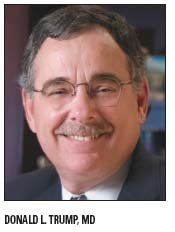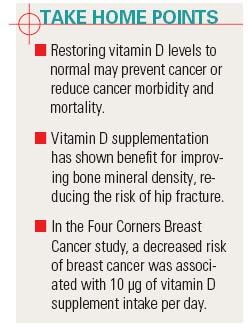Without randomized trials, role of vitaminD in cancer prevention remains uncertain
The Four Corners Breast Cancer Study is a population-based case-control study of women living in the southwestern states-Arizona, New Mexico, Colorado, and Utah.
Does vitamin D have a role to play in preventing cancer, and if it does, what is the optimal dose? At the 2009 American Society of Preventive Oncology meeting in Tampa, Fla., investigators presented data about vitamin D and cancer, with conflicting results: While some studies have indicated that vitamin D can lower risk, others have deduced that vitamin D may have no effect as a preventative or, even worse, may boost cancer risk. In the end, the experts agreed that only large, prospective, randomized trials will off er definitive answers.
Lowering risk
There is a substantial body of data to support the idea that vitamin D supplementation may prevent cancer, said Donald L. Trump, MD, professor of oncology at Roswell Park Cancer Institute in Buffalo, N.Y. Because the exact role of vitamin D in cancer and human health is unclear, and links are almost all associational, the subject needs to be scrutinized in rigorous randomized trials.

Many epidemiologic studies show an association between low vitamin D levels and increased cancer risk and mortality, he said. "One study, by Carol Hanchette, PhD, and Gary Schwartz, PhD, found that the geographic distributions of ultraviolet radiation and prostate cancer mortality were inversely correlated, with significantly lower rates of prostate cancer in the southern part of the United States compared to the north. Another study by Professor Nicholas J. Rukin and colleagues made a similar association," he said (Cancer Causes Control 17:1091-1101, 2006; Br J Cancer 96:523- 528, 2007).
Dr. Trump has explored whether low vitamin D levels could be a risk factor for prostate cancer. He measured vitamin D levels in 100 patients with recurrent prostate cancer and in controls. However, both patients and controls had similarly low levels of vitamin D, leading him to conclude that the low vitamin D levels were a reflection of Buffalo's geography and not a characteristic unique to cancer patients.
"Still, there are lots of other cities in North America at this latitude, so if this latitude is a risk factor for cancer, there are many other cities and large-population areas that are at the same risk," he said.
Dr. Trump said he believes that restoring vitamin D levels to normal can prevent cancer or reduce cancer morbidity and mortality. "Th e association data strongly suggest that that is the case," he said, citing a study by Joan M. Lappe, PhD, and colleagues (Am J Clin Nutr 85:1586-1591, 2007).
The study, a four-year, populationbased, double-blind, randomized, placebo- controlled trial, set out to measure fracture and cancer incidence among 1,179 community-dwelling postmenopausal women 55 years and older who were randomized to receive either 1,400 to 1,500 mg of supplemental calcium only per day, supplemental calcium plus 1,100 IU of vitamin D3 per day, or placebo. When analyzed by intention to treat, cancer incidence was lower in the calcium plus vitamin D group than in the placebo group (P < .03), leading the authors to conclude that improving calcium and vitamin D nutritional status substantially reduces all-cancer risk in postmenopausal women.
"I think the stage is set for trials in cancer therapy to determine the maximum tolerated dose of vitamin D and to conduct straightforward trials to demonstrate effi cacy and then, if positive, to proceed to phase III trials for prevention," Dr. Trump said.
Not a cancer preventative

Jacques Rossouw, MD, of the National Heart, Lung, and Blood Institute of the National Institutes of Health, showed data from the Women's Health Initiative, a complex of a large observational study plus three clinical trials on postmenopausal hormone therapy; low-fat dietary pattern; and calcium and vitamin D supplements conducted at 40 clinical centers around the U.S. Th e trials included 68,000 women (aged 50 to 79) who were relatively healthy and had no serious illness or prior cancer (including breast cancer) within 10 years of enrollment.
The primary endpoint of the calcium and vitamin D randomized study, which included 36,000 women, was to determine whether supplementation with 1,000 mg of elemental calcium plus 400 IU of vitamin D per day reduced hip fractures. The study also assessed the association between serum vitamin D levels and breast and colorectal cancer risk. Th e mean follow up was seven years (Curr Osteoporos Rep 5:153-159, 2007).
In this very large cohort of women, vitamin D supplementation showed no benefi t for cancer prevention. However, there was benefit for improved bone mineral density and a reduced risk of hip fracture. "The dose of 400 international units was suffi cient to show biologic effect. Th ese fi ndings raise serious doubt that vitamin D in larger doses will prove to be a useful strategy in preventing cancer," Dr. Rossouw said.
He questioned whether the lackluster results may have been because the vitamin D dose was simply too low. "I would think that it may be too low, but this was a very large, very long trial, and it worries me that there was absolutely no indication of benefi t with regard to breast and colorectal cancer. I do think that the result needs to be taken seriously," he said.
Dr. Rossouw said that the question will only be answered by doing another large and long-term trial using doses of vitamin D of the order of 2,000 IU daily to determine whether it has value for cancer prevention.

Mixed results in breast cancer Dana Rollison, PhD, from the H. Lee Moffi tt Cancer Center in Tampa, presented an analysis of the Four Corners Breast Cancer Study that showed that women with the highest levels of dietary vitamin D had an increased breast cancer risk but that women who took vitamin D supplements had a reduced breast cancer risk.
The Four Corners Breast Cancer Study is a population-based case-control study of women living in the southwestern states-Arizona, New Mexico, Colorado, and Utah. Cases of breast cancer were identified through the cancer registries of each of the four states and were diagnosed between 1999 and 2004. Ethnicity was based on self-report, and there were 1,524 cases of breast cancer in non-Hispanic white women and 7,571 cases of breast cancer in Hispanic women. Controls were matched with regard to age and ethnicity. The mean age of the study women was 55 years, and slightly more than half were postmenopausal (Am J Clin Nutr 87:978-984, 2008).

An interviewer-administered questionnaire collected data from the patients and controls on various breast cancer risk factors, including food consumption, and a blood sample was taken from all study participants.
Women in the highest quartile of dietary vitamin D intake, both Hispanic and non-Hispanic white women, had a 41% greater risk of breast cancer than women in the lowest quartile, which was “contrary to what we would expect,” Dr. Rollison said.
However, use of supplemental vitamin D showed the opposite effect. Hispanic and non-Hispanic white women who took at least 10 µg per day, had a significantly decreased risk of breast cancer (P = .01). “This protective trend was more pronounced in Hispanic women, where we saw a 34% reduced risk of breast cancer,” Dr. Rollison explained.
She added that this study was one of the first to characterize sources of vitamin D in an ethnic minority, in this case Hispanics. “Future studies should try to characterize this further,” she said.